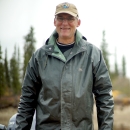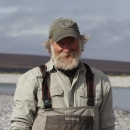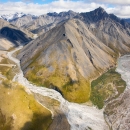In 2004 a large permafrost thaw slump began emitting substantial volumes of fine sediment into the Selawik River upstream from the Inconnu Stenodus leucichthys spawning area. Following this event, the once clear-flowing river ran turbid for about nine summers before the thaw slump stabilized and ceased emitting sediment. To determine if sediment input had a negative effect on egg survival and subsequent recruitment, we investigated: 1) age structure to identify the strength of cohorts from years before and after the thaw slump started; and 2) documented annual abundance of spawning inconnu to provide corroborative evidence of potential recruitment failure. For comparison, we obtained similar age structure data from Inconnu preparing to spawn in the Kobuk River, a neighboring drainage without a thaw slump. From 2011 to 2018, otoliths (aging), fork length, and weight samples were collected from 200 spawning Inconnu from the Selawik River. A similar but more variable number of samples were collected from Kobuk River Inconnu. Mean fork lengths of males in the Selawik River were greater than in the Kobuk River for most years, but males in the Kobuk River were heavier at a given length than in the Selawik River. Growth and length at age, was identical for the two populations. Mature Inconnu ages ranged from 9 to 34 in the Selawik River and 8 to 40 in the Kobuk River. Age histograms for both populations indicated variation in recruitment patterns. For both populations, intermittent periods of high recruitment were followed by periods of low recruitment. A large recruitment event occurred synchronously for both populations from 2015 to 2018. Abundance of spawning Inconnu in the Selawik River ranged from about 16,000 to 25,000 during the study but no correlation between abundance and recruitment was detected. During 2018, recruitment to the Selawik River spawning population was possible from up to five cohorts from years in which the slump was active, ages 9–13. Only the age-12 and 13 cohorts, spawned in 2005 and 2004, respectively, were represented from the Selawik River, albeit weakly. Ages 11–13 were more strongly represented from the Kobuk River. Because these cohorts from the thaw slump time period were in the early region of the ascending limb of the recruitment curve, the data did not establish that the thaw slump has affected recruitment. A subsequent age collection is recommended in 5 years to confirm this finding.
Publication date
Type of document
Report
Facility
Program
Species
FWS and DOI Region(s)






